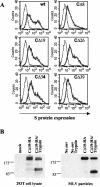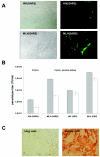Retroviral vectors pseudotyped with severe acute respiratory syndrome coronavirus S protein
- PMID: 15308697
- PMCID: PMC506966
- DOI: 10.1128/JVI.78.17.9007-9015.2004
Retroviral vectors pseudotyped with severe acute respiratory syndrome coronavirus S protein
Abstract
The worldwide outbreak of severe acute respiratory syndrome (SARS) was shown to be associated with a novel coronavirus (CoV) now called SARS CoV. We report here the generation of SARS CoV S protein-pseudotyped murine leukemia virus (MLV) vector particles. The wild-type S protein pseudotyped MLV vectors, although at a low efficiency. Partial deletion of the cytoplasmic tail of S dramatically increased infectivity of pseudotypes, with titers only two- to threefold lower than those of pseudotypes generated in parallel with the vesicular stomatitis virus G protein. S-pseudotyped MLV particles were used to analyze viral tropism. MLV(SARS) pseudotypes and wild-type SARS CoV displayed similar cell types and tissue and host restrictions, indicating that the expression of a functional receptor is the major restraint in permissiveness to SARS CoV infection. Efficient gene transfer could be detected in Vero and CaCo2 cells, whereas the level of gene marking of 293T, HeLa, and HepG2 cells was only slightly above background levels. A cat cell line and a dog cell line were not susceptible. Interestingly, PK-15, a porcine kidney cell line, and primary porcine kidney cells were also highly permissive for SARS S pseudotypes and wild-type SARS CoV. This finding suggests that swine may be susceptible to SARS infection and may be a source for infection of humans. Taken together, these results indicate that MLV(SARS) pseudotypes are highly valuable for functional studies of viral tropism and entry and, in addition, can be a powerful tool for the development of therapeutic entry inhibitors without posing a biohazard to human beings.
Figures






References
MeSH terms
Substances
LinkOut - more resources
Full Text Sources
Other Literature Sources
Miscellaneous

